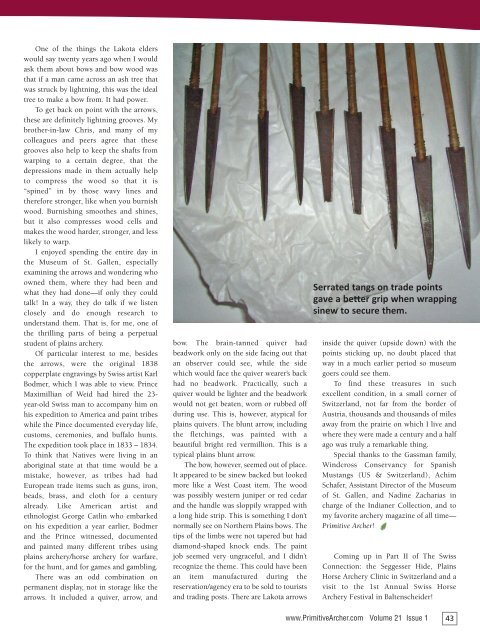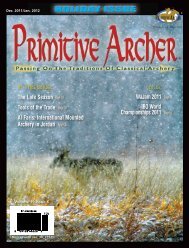In This Issue: plus: - Primitive Archer Online
In This Issue: plus: - Primitive Archer Online
In This Issue: plus: - Primitive Archer Online
Create successful ePaper yourself
Turn your PDF publications into a flip-book with our unique Google optimized e-Paper software.
One of the things the Lakota elders<br />
would say twenty years ago when I would<br />
ask them about bows and bow wood was<br />
that if a man came across an ash tree that<br />
was struck by lightning, this was the ideal<br />
tree to make a bow from. It had power.<br />
To get back on point with the arrows,<br />
these are definitely lightning grooves. My<br />
brother-in-law Chris, and many of my<br />
colleagues and peers agree that these<br />
grooves also help to keep the shafts from<br />
warping to a certain degree, that the<br />
depressions made in them actually help<br />
to compress the wood so that it is<br />
“spined” in by those wavy lines and<br />
therefore stronger, like when you burnish<br />
wood. Burnishing smoothes and shines,<br />
but it also compresses wood cells and<br />
makes the wood harder, stronger, and less<br />
likely to warp.<br />
I enjoyed spending the entire day in<br />
the Museum of St. Gallen, especially<br />
examining the arrows and wondering who<br />
owned them, where they had been and<br />
what they had done—if only they could<br />
talk! <strong>In</strong> a way, they do talk if we listen<br />
closely and do enough research to<br />
understand them. That is, for me, one of<br />
the thrilling parts of being a perpetual<br />
student of plains archery.<br />
Of particular interest to me, besides<br />
the arrows, were the original 1838<br />
copperplate engravings by Swiss artist Karl<br />
Bodmer, which I was able to view. Prince<br />
Maximillian of Weid had hired the 23year-old<br />
Swiss man to accompany him on<br />
his expedition to America and paint tribes<br />
while the Pince documented everyday life,<br />
customs, ceremonies, and buffalo hunts.<br />
The expedition took place in 1833 – 1834.<br />
To think that Natives were living in an<br />
aboriginal state at that time would be a<br />
mistake, however, as tribes had had<br />
European trade items such as guns, iron,<br />
beads, brass, and cloth for a century<br />
already. Like American artist and<br />
ethnologist George Catlin who embarked<br />
on his expedition a year earlier, Bodmer<br />
and the Prince witnessed, documented<br />
and painted many different tribes using<br />
plains archery/horse archery for warfare,<br />
for the hunt, and for games and gambling.<br />
There was an odd combination on<br />
permanent display, not in storage like the<br />
arrows. It included a quiver, arrow, and<br />
bow. The brain-tanned quiver had<br />
beadwork only on the side facing out that<br />
an observer could see, while the side<br />
which would face the quiver wearer’s back<br />
had no beadwork. Practically, such a<br />
quiver would be lighter and the beadwork<br />
would not get beaten, worn or rubbed off<br />
during use. <strong>This</strong> is, however, atypical for<br />
plains quivers. The blunt arrow, including<br />
the fletchings, was painted with a<br />
beautiful bright red vermillion. <strong>This</strong> is a<br />
typical plains blunt arrow.<br />
The bow, however, seemed out of place.<br />
It appeared to be sinew backed but looked<br />
more like a West Coast item. The wood<br />
was possibly western juniper or red cedar<br />
and the handle was sloppily wrapped with<br />
a long hide strip. <strong>This</strong> is something I don’t<br />
normally see on Northern Plains bows. The<br />
tips of the limbs were not tapered but had<br />
diamond-shaped knock ends. The paint<br />
job seemed very ungraceful, and I didn’t<br />
recognize the theme. <strong>This</strong> could have been<br />
an item manufactured during the<br />
reservation/agency era to be sold to tourists<br />
and trading posts. There are Lakota arrows<br />
Serrated tangs on trade points<br />
gave a better grip when wrapping<br />
sinew to secure them.<br />
inside the quiver (upside down) with the<br />
points sticking up, no doubt placed that<br />
way in a much earlier period so museum<br />
goers could see them.<br />
To find these treasures in such<br />
excellent condition, in a small corner of<br />
Switzerland, not far from the border of<br />
Austria, thousands and thousands of miles<br />
away from the prairie on which I live and<br />
where they were made a century and a half<br />
ago was truly a remarkable thing.<br />
Special thanks to the Gassman family,<br />
Windcross Conservancy for Spanish<br />
Mustangs (US & Switzerland), Achim<br />
Schafer, Assistant Director of the Museum<br />
of St. Gallen, and Nadine Zacharias in<br />
charge of the <strong>In</strong>dianer Collection, and to<br />
my favorite archery magazine of all time—<br />
<strong>Primitive</strong> <strong>Archer</strong>!<br />
Coming up in Part II of The Swiss<br />
Connection: the Seggesser Hide, Plains<br />
Horse <strong>Archer</strong>y Clinic in Switzerland and a<br />
visit to the 1st Annual Swiss Horse<br />
<strong>Archer</strong>y Festival in Baltenscheider!<br />
www.<strong>Primitive</strong><strong>Archer</strong>.com Volume 21 <strong>Issue</strong> 1 43



